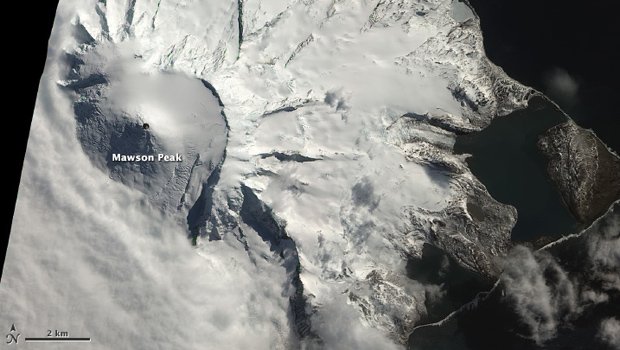Australian volcano about to erupt?

ONE OF ONLY TWO active volcanoes in Australian territory is showing possible signs of eruption.
Satellite thermal imagery collected by NASA’s Earth Observing System (EOS) during the past month indicates volcanic activity is occurring at Big Ben, a volcano located on remote Heard Island, about 4100km southwest of Perth, in the sub-Antarctic.
Thermal anomalies at Mawson’s Peak, the 2745m summit of Big Ben, were documented this year on 21 and 24 September, and 10 and 19 October using infrared data provided by the Moderate Resolution Imaging Spectroradiometer (MODIS), a key instrument aboard each of the two EOS satellites.
An image taken by one of the satellite’s Advanced Land Imagers (ALI) on October 13 also shows a snow- and ice-free area at Mawson’s Peak, indicating a possible hotspot in the volcano’s crater.
“The satellites that volcano scientists use are basically weather and environmental satellites, and they provide up to two images per day over any given spot on Earth,” says Dr Matthew Patrick, a research geologist at the Hawaiian Volcano Observatory. “The satellites collect both visible wavelength images and thermal images. The thermal images, which are really designed to spot forest fires, respond well to the high surface temperatures common during volcanic eruptions.”
Remote Heard Island volcano no threat to humans
Heard Island is remote and uninhabited and scientists say the volcanic activity poses no threat to humans.
“The type of activity that Heard has had over the last 10 years, based on my analyses of the satellite data, is quite benign and low level,” says Matthew. “In a few cases, the lava creeps out of the summit vent crater and flows a mile or two down the steep flanks. But overall the eruption style is not explosive, and typical activity would not pose a widespread hazard.”
Dr Rebecca Carey, a researcher at the University of Tasmania’s School of Earth Sciences agrees. “Heard Island is so remote that there is no danger to humans,” she says. “Large eruptions can put ash into the atmosphere which can have some far-reaching effects, such as disruption to air traffic and air quality, however the eruption history of Heard Island that we know about suggests that a large eruption is not likely.”
Heard Island is located about 1500km north of Antarctica in the Southern Indian Ocean. It covers about 368sq.km, making it about twice the size of Brisbane’s Moreton Island. It is a breeding ground for elephant and fur seals, penguins and seabirds.
“Due to the remoteness of the island, it’s difficult at this stage to assess whether there is a risk for wildlife on the island,” says Rob Bryson, the Australian Antarctic Division’s territories, environment and treaties manager. “From our past experience when expeditions have been on the island the wildlife usually relocates pretty quickly in response to events such as this, and usually are in areas located distant from the eruption sites and close to the water’s edge.”
Previous volcanic eruptions on Heard Island
Heard Island has experienced three eruptive episodes during the past 10 years. “The last few episodes lasted about a year or more each, and each comprised low level lava activity, mostly within the vent crater,” says Matthew. “The recent satellite data suggest that it is starting its fourth episode.”
Rebecca says researching the island’s long-term volcanic history could help scientists understand present and future volcanic activity.
“Heard Island is the summit expression on the Kerguelen Plateau, which is the second largest submarine plateau in the world,” she says. “We have a limited understanding of the eruptive and geological history of this plateau, island and volcano and so it is difficult to say whether this is a period of escalated activity on longer timescales. We need to learn more about its eruptive past to understand the present and future eruptive activity of this volcano.”
While satellite data is critical for providing scientists with the tools they need to do this, regular heavy cloud cover over Heard Island can make data collection difficult.
“The most significant advancement of our knowledge would be gained from getting boots on the ground,” Rebecca says.
Want to see Heard Island for yourself? Find out more about the AG Society expedition there.
RELATED STORIES

